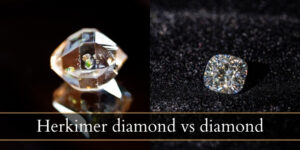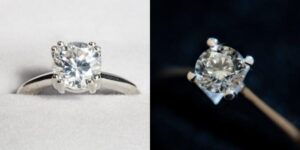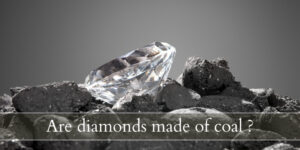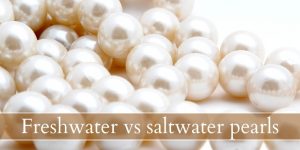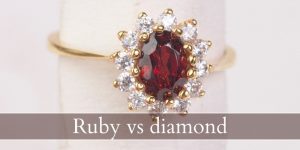In the market for the perfect engagement ring diamond ? You’re probably thinking of the round cut diamond, and might even have your eye on another one. Perhaps the oval cut ? An oval cut and round cut have quite a few things in common, which would make choosing just one of them as the diamond you’ll wear every day for the rest of your life a big choice.
So today we’re focusing on round vs oval cut diamonds, and comparing the two so you get a very clear idea of how they’re different but also similar. As with any diamond at all, you should still visit a jeweler after reading this comparison. Reading about a diamond is one thing, but seeing it sparkle on your finger is another.
Round vs oval diamond
Round cut diamonds are the go-to diamond shape while ovals are second place, right along with cushion cuts and princess cuts. The oval diamond will slenderize and elongate most fingers while the round cut suits any finger and hand. There is a bow tie in the oval diamond that can influence the final look of the diamond, which a round cut does not have. And there is a significant price difference between ovals and round, with round being about 30% more expensive than any other cut.
What is a round cut ?
The round cut diamond is also known as the round brilliant cut. It is derived from the old European cut, and it’s meant to maximize a diamond’s sparkle potential. The modern round brilliant is designed specifically for a diamond’s refractive index (2.42) is it can have the maximum amount of sparkle that is physically possible.
The round cut appears like a perfect circle face-up, hence the name. Its faceting style (brilliant cut, as opposed to step-cut) is meant to provide as many small facets as possible so the diamond reflects and refracts the light into both fire and brilliance.
The round brilliant, or simply known as the round cut, is the most popular diamond cut style of all time. It’s been around for centuries, and it’s been improved upon to perfection. There are many variations on it, but even the most traditional, classic round cut is still going to surpass other cuts.
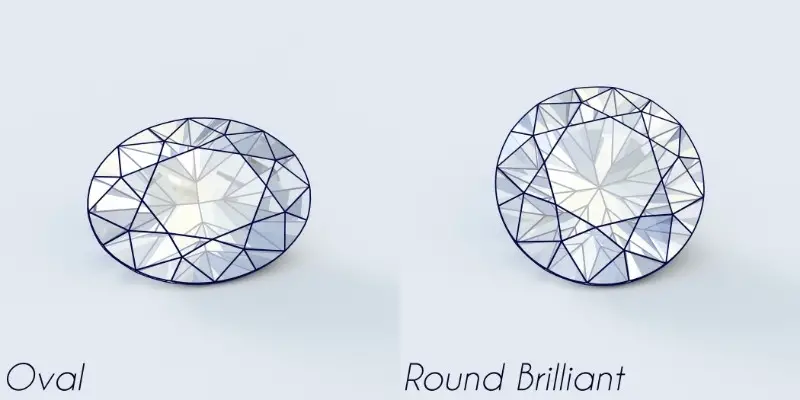
What is an oval cut ?
The oval cut diamond appears like an oval face-up, and you could even say it looks like an elongated round cut. There are different ratios for this kind of diamond cut, with thinner or wider points, skinny and tall oval, short and full ovals, and any combination you can think of. When shopping for an oval cut the L/W ratio is really important, so you should know the usual ratio is 1.20-1.60:1. The bigger the ratio, the skinnier and taller the oval.
Oval cut diamonds are relatively new, in comparison to round cuts. They’re been around since the mid 1900s and they’ve been quite popular every since. A key feature of an oval cut, no matter the quality, is the bow tie effect. Some don’t mind it, and some avoid it entirely, and we’ll explain this in a bit. Now let’s compare the round cut with the oval cut in detail.
1. Oval diamonds elongate the finger, round cuts suit everyone
Right off the bat the first difference you’ll notice is the shape, one round and one oval. But that oval shape wins quite a few hearts, simply because it is flattering for most people. Any elongated shape (including the oval) will make your finger appear longer and more slender, especially if the ratio on the oval is around 1.30:1.
Meanwhile the round cut suits absolutely everyone. It is as neutral as it gets. It does not point this way, or sit that way. A round brilliant works with any hand shape, finger shape, fashion style, and overall aesthetic. The round cut really is for everyone, while the oval cut is for most people.
Read also: Emerald VS Princess Cut Diamonds
2. Round cut diamonds are the most expensive and popular
Does the round cut sound great so far ? Well, many people think so, so you better be prepared to pay a little extra for the round cut when compared to the oval cut.
Generally the round brilliant diamond is about 30% more expensive than another diamond shape with the same specifications *color, clarity, carat, etc). This means any oval you look at will be at least 30% less than a round cut.
This is because the round cut is highly popular, it goes great with anything, and it sells the fastest. It’s also the easiest to work with, as far as jewelry settings go. You also have a whole lot more options when looking at a round cut as opposed to an oval cut. there are about 25 times more round cuts produced than oval cuts, so you will have plenty to choose from and plenty of room to tweak for clarity, color, size, and cut grade.
Oval cuts aren’t that popular, or rather they are popular but not as much as the round brilliant. If you’re looking for something a little unique then the oval is definitely a good choice, as there are simply fewer brides with an oval ring than a round one.
3. Oval cuts tend to have a bowtie, round cuts do not
We mentioned the bow tie effect at the beginning of this post. Oval cut diamond are notorious for this, but it doesn’t have to be a bad thing, rather something you should be aware of before making the decision to commit to this cut. You might like it, you might not. Let us explain.
An oval cut is an elongated cut, and at its pavilion, right in the very center, the facets become wider than the ones near the edges. This results in an area that is darker, or more shadowy when compared to the rest of the diamond. The light does not enter the diamond the same, and thus a dark area forms. It has the shape of a bow tie, or a figure 8, flaring from the center of the diamond to the sides.
Absolutely all oval cut diamond have a bow tie, there is no way around it. But, there are ovals with a bow tie that is much less noticeable. It’s usually the quality of the cut that influences the severity of the bow tie. Some people like the look and consider it ass a more dramatic flair to the diamond, while some consider it something to avoid because it darkens the diamond.
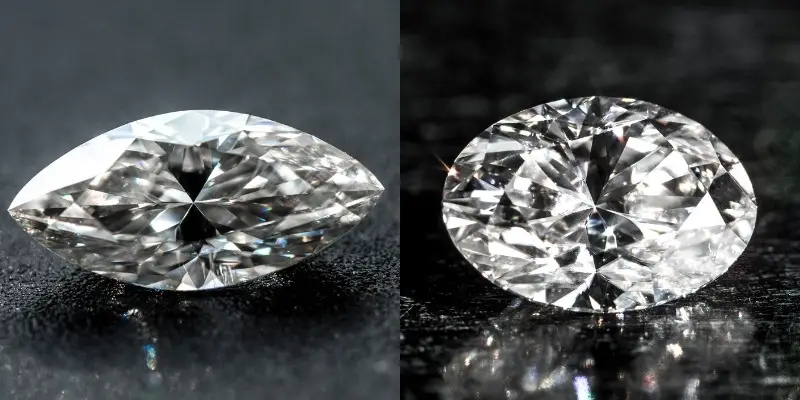
This bow tie effect is also present in pear cuts and marquise cuts, as their pavilions are extremely similar to that of an oval cut, especially the marquise. The round cut does not have a bow tie, so this is one less thing to worry about.
4. Round cuts have a classic sparkle, oval cuts have crushed ice
In terms of sparkle the round brilliant diamond has that classic scintillation, with plenty of fire (rainbow flashes) and a good amount of brilliance (white light). This makes it the perfect diamond for those who really want to shine, or the perfect diamond for the fiancee who likes the glamor and might even enjoy the center stage. This is that classic sparkle with chunky facets, the kind of sparkle we all associate with diamonds.
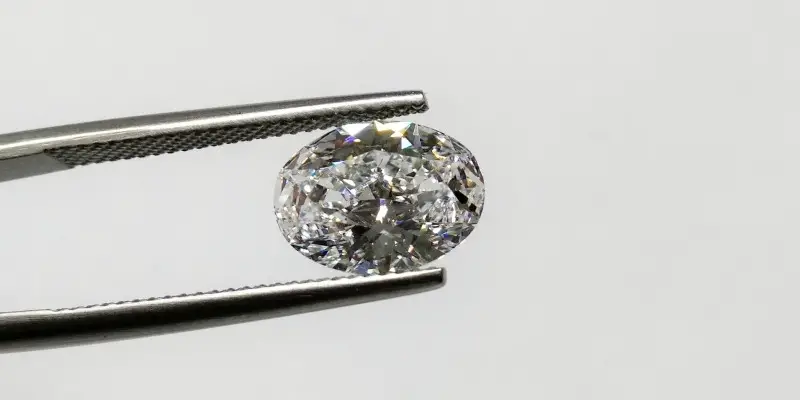
Oval cut diamonds are a little different, in that their sparkle is split into two types. Towards the center of the stone it’s the chunkier kind, chunkier than the round brilliant because the facets are quite large. And towards the edges and points, it’s crushed ice due to the many, many tiny facets on the pavilion and crown. The overall sparkle is the crushed ice though, so you’ll see tiny flashes of fire and brilliance more than you’ll see chunks of them.
5. Oval cuts face up bigger than round cuts
Oval cuts will always appear larger than round cuts of the same carat weight, simply for being longer and more shallow. They carry most of their weight in their length and crown, and they splay more than a round cut.
So a 1.00 carat oval might just look wider and longer than a 1,00 carat round brilliant. And that’s okay, it even allows you to go a bit less in carat weight as long as the millimeter measurements are the ones that fit your hand and design.
6. Round cuts are always round, ovals have different L/W ratios
Round cuts have a standard look to them, always round when viewed from the top. But oval diamonds have different length to width ratios, just like any elongated shape diamond. So you could be looking at two tall, skinny ovals, one with a pointier end and one with a perfectly round one. You could be looking at a 1ct short, wide oval that is cut deep and a 0.7 ct perfect ratio oval that is cut very shallow and they could measure the same.
Really, an oval diamond’s shape will dictate so many things, including what kind of design it goes best in, what hands it suits, and it may also affect the diamond’s light performance.
And because of their different shapes, oval diamonds may be more difficult to set in some designs, such as a split shank. But you also have the opportunity to set your oval in an east-west setting, quite different from the usual north-south.
7. Oval cuts show more inclusions and color than round cuts
Oval cuts are often cut more shallow than a round cut. This results in a thinner crown-to-pavilion measurement near the edges, allowing the inclusions to be seen easier than they would in a round cut. And near the center of the diamond, where the bow tie is, the facets are wider so they will show an inclusion even better.
In terms of color, an oval would normally hide it just fine but the contrast between the crushed ice part and the chunky facet part reveals any color lower than a G, possibly even an H. Meanwhile the round cut hides both inclusions and color quite well.
Similarities between oval and round cuts
All that being said, there are still a couple of similarities between round cuts and oval cuts that make the choice difficult. You can look at these similarities as a certainty that no matter which diamond you choose, you the will behave similarly. Here’s what we mean.
Both oval and round cuts work great as halo or solitaire
If you’re stuck between a solitaire and halo setting, you will be thrilled to know that both the oval and the round cut work very well both with halos and as solitaires. They both work great with a prong setting, so really it’s just about the shape at this point. Round halos are a little less common than oval halos, if you’re really looking for a difference, but both will do just fine.
Both round and oval cuts have soft, curved edges, go with anything
Worries about the overall look of your diamond ring ? Both the round cut and the oval cut have a soft, organic aesthetic which mean they will go with pretty much any fashion style you have, or general lifestyle. They have no sharp edges to snag on clothing, as long as the prongs used are well polished.
The round cut is a little more neutral, as it doesn’t lean towards very feminine, masculine, or even futuristic in terms of aesthetic. The oval is a bit on the classic, feminine side but that, too, can easily be incorporated into something that is minimalist and even modern.

I’m the main author for jewelrymaterialguide.com. I started this site after we did tons of research before our wedding and noticed that there is information about rings, jewelry, and so on that is really hard to find on the internet.

